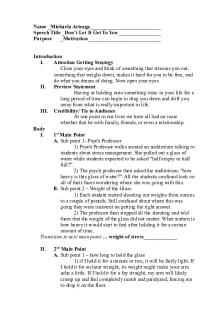Food For Motivational Thoughts PDF

| Title | Food For Motivational Thoughts |
|---|---|
| Author | Kaitlyn Mathews |
| Course | Psychological Aspects Of Sport And Exercise |
| Institution | Angelo State University |
| Pages | 2 |
| File Size | 64.9 KB |
| File Type | |
| Total Downloads | 2 |
| Total Views | 140 |
Summary
got a 100...
Description
Food for Motivational Thought Questions As the book points out, understanding motivation is critical to being a successful teacher, coach, or exercise leader. This activity will help you achieve some of that understanding. Instructions Answer the following questions based on your own experiences in sport and physical activity.
1. Define the two main aspect of motivation. The two main aspects of motivation are direction of effort and intensity of effort. Direction of effort refers to whether an individual seeks, approaches, or is attracted to situations. Intensity of effort refers to how much effort an individual puts form in a situation.
2. How has the direction of your effort varied in different sport, physical education, or exercise settings? Provide some examples. The direction of my effort depends on what sport I am participating in. For example, I ran track for nine years and gave my all in the sport because it was my favorite and I excelled at it. When I played volleyball and basketball in middle school, I only played because my friends played and did not care for the sport otherwise.
3. How has the intensity of your effort varied in different sport, physical education, or exercise settings? Provide some examples. The intensity of my effort varies on the competition. For example, when I ran track, and we went to small meets I would not give my all because we competed against small schools and they were not very good. I knew that I could win the race without running as hard as I needed to.
From R.S. Weinberg and D. Gould, 2019, Foundations of Sport and Exercise Psychology Web Study Guide, 7E (Champaign, IL: Human Kinetics).
1
4. What are the key points of the trait-centered view of motivation? Provide an example of what someone who holds that view might say. The key points of trait-centered view of motivation is motivated behavior is primarily a function of individual characteristics, personality, needs, interests, and goals of an athlete or student are primary determinants of motivated behavior. Someone with this view might say, “He was born to be a winner.”
5. What are the key points of the situation-centered view of motivation? Provide an example of what someone who holds that view might say. The key points of situation-centered view of motivation is motivation level is determined primarily by the situation, and a person can be motivated in negative environments, so other factor are involved for motivation. Someone with this view might say, “It’s to hot today so I can’t play the rest of the game.”
6. What are the key points of the interactional view of motivation? Provide an example of what someone who holds that view might say. The key points of interactional view of motivation is motivated behavior results from the interaction of participant factors and situational factors. Someone with this view might say, “I’m not very good at this sport, but I will put my best efforts forth.”
From R.S. Weinberg and D. Gould, 2019, Foundations of Sport and Exercise Psychology Web Study Guide, 7E (Champaign, IL: Human Kinetics).
2...
Similar Free PDFs

Food For Motivational Thoughts
- 2 Pages

Motivational Interviewing
- 13 Pages

MOTIVATIONAL INTERVIEWING
- 4 Pages

Food-waste - summary for food waste
- 83 Pages

Food For Thought Notes
- 49 Pages

Food for Thought Summary
- 1 Pages

Motivational Modelling Handout
- 14 Pages

Outline motivational speech
- 3 Pages

Three Motivational Theories
- 5 Pages

COM 335A Motivational Appeals
- 1 Pages

Motivational interviewing relias
- 5 Pages

Thoughts on The Dutchman
- 1 Pages

Assignment notes for food diary
- 9 Pages
Popular Institutions
- Tinajero National High School - Annex
- Politeknik Caltex Riau
- Yokohama City University
- SGT University
- University of Al-Qadisiyah
- Divine Word College of Vigan
- Techniek College Rotterdam
- Universidade de Santiago
- Universiti Teknologi MARA Cawangan Johor Kampus Pasir Gudang
- Poltekkes Kemenkes Yogyakarta
- Baguio City National High School
- Colegio san marcos
- preparatoria uno
- Centro de Bachillerato Tecnológico Industrial y de Servicios No. 107
- Dalian Maritime University
- Quang Trung Secondary School
- Colegio Tecnológico en Informática
- Corporación Regional de Educación Superior
- Grupo CEDVA
- Dar Al Uloom University
- Centro de Estudios Preuniversitarios de la Universidad Nacional de Ingeniería
- 上智大学
- Aakash International School, Nuna Majara
- San Felipe Neri Catholic School
- Kang Chiao International School - New Taipei City
- Misamis Occidental National High School
- Institución Educativa Escuela Normal Juan Ladrilleros
- Kolehiyo ng Pantukan
- Batanes State College
- Instituto Continental
- Sekolah Menengah Kejuruan Kesehatan Kaltara (Tarakan)
- Colegio de La Inmaculada Concepcion - Cebu


